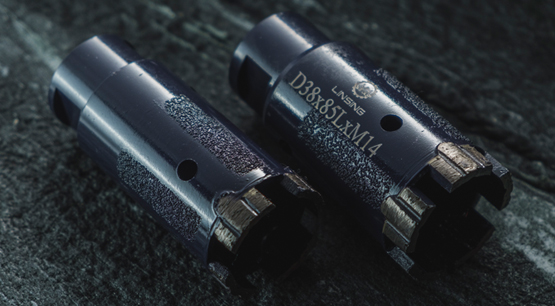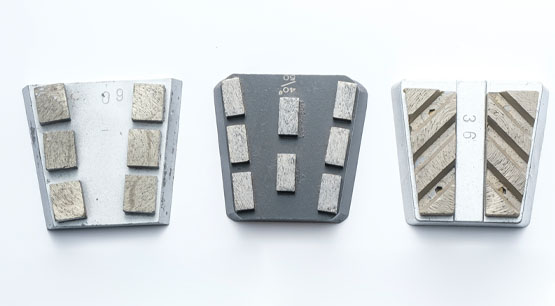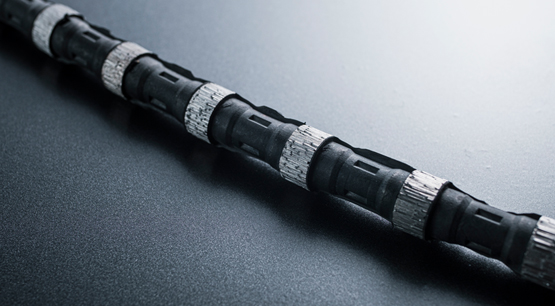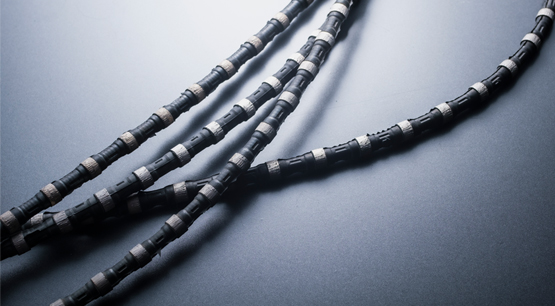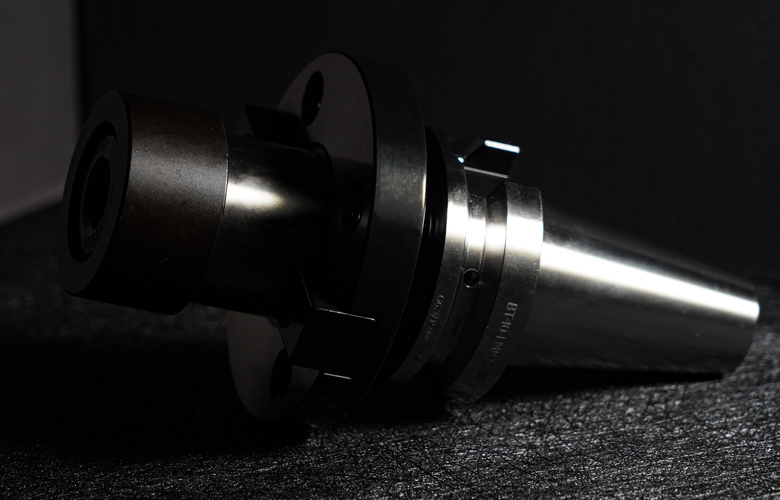I. Specifications of the Thinnest Diamond Wire Saws
1. Wire Diameter
- Range: The diameter of thin diamond wire saws typically ranges from 0.10 mm to 0.50 mm. These ultra-thin wires are designed for tasks requiring high precision and minimal kerf loss.
- Common Diameters:
- 0.10 mm
- 0.15 mm
- 0.20 mm
- 0.25 mm
- 0.30 mm
- 0.35 mm
- 0.40 mm
- 0.50 mm
2. Diamond Bead Size
- Small Beads: The beads used in thin wire saws are smaller in size to maintain the integrity of the wire and ensure a smooth cutting surface. Common bead sizes range from 0.3 mm to 0.7 mm.
- Distribution: Beads are evenly distributed along the wire to provide consistent cutting performance and reduce stress on the wire.
3. Core Material
- High-Strength Alloys: The core of thin diamond wire saws is typically made from high-strength steel or specialized alloys to withstand the mechanical stresses during cutting.
- Coating: Some wires are coated with materials such as nickel to enhance durability and resistance to wear.
4. Bonding Technology
- Electroplating: For ultra-thin wires, electroplating is a common bonding technique. This process ensures that the diamond particles are securely attached to the wire core, providing a durable cutting edge.
- Resin Bonding: In some cases, resin bonding is used for specific applications where a softer bond is required for better performance in delicate materials.
II. Applications of the Thinnest Diamond Wire Saws
1. Semiconductor and Electronics Industry
Silicon Wafer Cutting: Thin diamond wire saws are extensively used for slicing silicon wafers in the semiconductor industry. The ultra-thin wires ensure minimal kerf loss, which is critical for maximizing the number of wafers produced from a single silicon ingot.
- Diameter: Commonly 0.10 mm to 0.20 mm.
- Advantages: High precision, minimal material loss, and smooth cutting surfaces.
LED Substrates: Cutting sapphire and silicon carbide substrates for LED production requires high precision. Thin diamond wire saws provide the necessary accuracy and surface finish.
- Diameter: Typically 0.15 mm to 0.30 mm.
- Advantages: Reduced chipping and cracking, high-quality cuts.
2. Photovoltaic Industry
- Solar Cell Production: Thin diamond wire saws are used to slice silicon blocks into thin wafers for solar cell manufacturing. The thin wires help in reducing material loss and improving the efficiency of the cutting process.
- Diameter: Generally 0.16 mm to 0.20 mm.
- Advantages: High throughput, low kerf loss, and excellent surface quality.
3. Precision Machining and Microfabrication
Microelectronics: In microelectronics, cutting materials like glass, ceramics, and thin metals with high precision is essential. Thin diamond wire saws offer the required accuracy for these delicate operations.
- Diameter: Ranges from 0.10 mm to 0.25 mm.
- Advantages: High precision, minimal thermal damage, and smooth edges.
Optical Components: Manufacturing optical components like lenses and prisms involves cutting high-precision glass and crystals. Thin diamond wire saws ensure high-quality cuts with minimal waste.
- Diameter: Typically 0.20 mm to 0.30 mm.
- Advantages: Excellent surface finish, reduced chipping, and high precision.
4. Medical Industry
Medical Device Manufacturing: The production of medical devices often requires cutting extremely hard materials like titanium and stainless steel with high precision. Thin diamond wire saws provide the necessary accuracy and cleanliness.
- Diameter: Commonly 0.20 mm to 0.30 mm.
- Advantages: Precise cuts, minimal material loss, and smooth finishes.
Bone and Tissue Slicing: In medical research and pathology, thin diamond wire saws are used to slice bone and tissue samples for microscopic examination. The thin wires ensure precise and clean cuts, preserving the integrity of the samples.
- Diameter: Typically 0.15 mm to 0.25 mm.
- Advantages: High precision, minimal damage to samples, and clean cuts.
5. Jewelry and Gemstone Industry
Gem Cutting: Thin diamond wire saws are ideal for cutting and shaping gemstones. The precision and minimal kerf loss provided by these wires are crucial for maximizing the yield and quality of the finished product.
- Diameter: Generally 0.20 mm to 0.30 mm.
- Advantages: High precision, minimal material waste, and smooth cutting surfaces.
Jewelry Manufacturing: Cutting precious metals and delicate designs in jewelry manufacturing requires high precision. Thin diamond wire saws offer the accuracy needed for intricate cuts.
- Diameter: Typically 0.25 mm to 0.35 mm.
- Advantages: Precise cuts, reduced material waste, and high-quality finishes.
6. Research and Development
Material Science Research: Thin diamond wire saws are used in research laboratories to cut and prepare samples of various materials, including metals, ceramics, and composites. The thin wires allow for high precision and minimal sample damage.
- Diameter: Ranges from 0.10 mm to 0.25 mm.
- Advantages: High precision, minimal sample loss, and clean cuts.
Prototype Development: In the development of prototypes, particularly for electronics and medical devices, thin diamond wire saws are essential for creating precise and intricate components.
- Diameter: Typically 0.20 mm to 0.30 mm.
- Advantages: High precision, minimal material loss, and excellent surface quality.
III. Advantages of Thin Diamond Wire Saws
1. Precision and Accuracy
- Fine Cuts: The thin diameter allows for extremely fine and precise cuts, essential in industries where accuracy is critical.
- Minimal Kerf Loss: Thin wires reduce the amount of material lost during cutting, which is particularly important for expensive materials like silicon and gemstones.
2. Efficiency
- High Cutting Speed: Despite their thinness, these wires can maintain high cutting speeds, improving overall productivity.
- Reduced Waste: Minimal kerf loss means less material waste, translating to cost savings and higher yield.
3. Surface Quality
- Smooth Finishes: Thin diamond wire saws produce smooth and clean cut surfaces, reducing the need for further processing and polishing.
- Reduced Chipping: The precision of thin wires minimizes chipping and cracking, which is crucial for brittle materials like silicon and glass.
4. Versatility
- Wide Range of Materials: These wire saws can cut a variety of materials, from hard metals to delicate semiconductors, making them versatile tools for multiple industries.
- Customizable: Manufacturers can tailor the specifications of thin diamond wire saws to meet specific requirements, including different bead sizes, concentrations, and bonding techniques.
IV. Conclusion
Thin diamond wire saws, with diameters ranging from 0.10 mm to 0.50 mm, are indispensable tools in various high-precision industries. Their ability to make fine, accurate cuts with minimal material loss makes them ideal for applications in the semiconductor, photovoltaic, precision machining, medical, jewelry, and research sectors. The advanced manufacturing techniques and high-quality materials used in producing these wire saws ensure their performance, durability, and efficiency. As technology advances and the demand for precision increases, the role of thin diamond wire saws will continue to expand, driving innovation and excellence across multiple fields.




